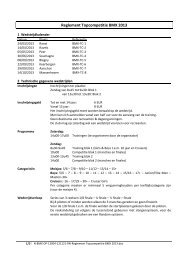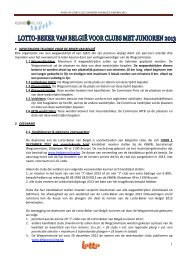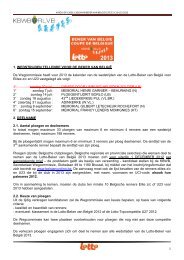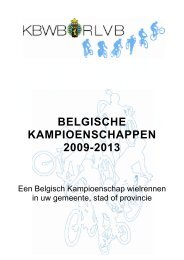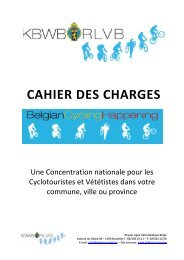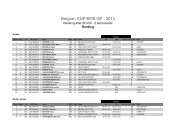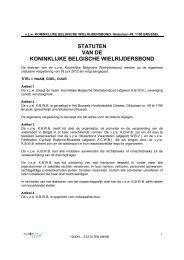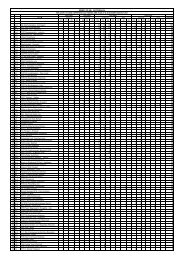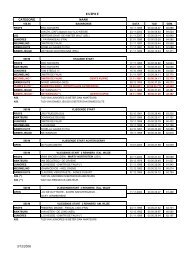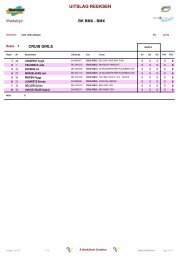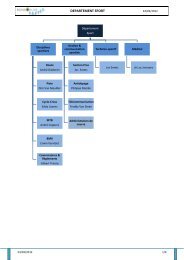Practical guide for organising mountain bike events - UCI
Practical guide for organising mountain bike events - UCI
Practical guide for organising mountain bike events - UCI
Create successful ePaper yourself
Turn your PDF publications into a flip-book with our unique Google optimized e-Paper software.
<strong>Practical</strong> <strong>guide</strong> <strong>for</strong> <strong>organising</strong> hc | c1 | c2 | c3 <strong>mountain</strong> <strong>bike</strong> <strong>events</strong><strong>Practical</strong> <strong>guide</strong> <strong>for</strong> <strong>organising</strong> hc | c1 | c2 | c3 <strong>mountain</strong> <strong>bike</strong> <strong>events</strong>2Draw up a Marshal position plan (numbered) showing where the marshals and first aid people are positioned. This plancan be altered by the President of the Commissaires Panel when the course is inspected.Example of the plan showing marshal positions:They will be stationed at strategic points on the course such that they are in direct line of sight with theirtwo closest colleagues earlier and later on the course.The red flags will be used in training and racing.Red flag marshals who see a serious accident shall immediately notify the marshal coordinator by radio,who shall as soon as possible notify the president of the commissaires’ panel, the <strong>organising</strong> director, themedical team and, where present, the <strong>UCI</strong> technical delegate.Red flag holders must immediately assess the situation of the crashed rider and continue reporting by radioto the marshal coordinator.Red flag marshals who are not directly affected by an accident shall follow the relevant radio transmissions.If they note that one of their colleagues further down the course is waving their red flag, they shall immediatelydo the same.4.3.018 Riders observing a waving red flag during the race must stop immediately.A stopped rider should continue calmly to the finish and request a re-start from the finish judge and wait <strong>for</strong>further instruction.• Training sessionIn accordance with the <strong>UCI</strong> Rules, training sessions must be conducted in the following way:264.3.020 The following training sessions must be organised:• a foot inspection of the course must be organised be<strong>for</strong>e the first training session.• a morning training session, possibly with breaks, the day be<strong>for</strong>e competition.• a training session without breaks the day prior to the competition.• an optional session on the morning of the day of the race.No training is permitted whilst a race is in progress.274.3.021 Each rider must complete at least two training runs on pain of disqualification. The start commissaire shallensure that this rule is applied.4.3.022 Riders must start all training runs at the official start gate. Any rider starting a training run below the startline shall be disqualified from the competition.4.3.023 Riders must display their handlebar number while training.• Transport to the top of the courseThe minimum passenger flow must be 100 riders an hour, including <strong>bike</strong>s.If the transport system is shared by the riders and the spectators, the riders take priority.Make sure the operations flow smoothly. Avoid long queues and provide a sheltered staging area close to the start.Take measures to protect the <strong>bike</strong>s from being damaged duringtransportation. The organiser is liable.• Procedure <strong>for</strong> stoppage of racesThe procedure <strong>for</strong> stoppage of races is carried out in the order described below by the <strong>UCI</strong> rules:4.3.017 Some marshals specifically appointed by the organiser and the marshal coordinator shall carry a red flag andwill have a radio link on the same frequency as those of the president of the commissaires’ panel, the <strong>organising</strong>director, the medical team, the marshal coordinator and, where present, the <strong>UCI</strong> technical delegate..Provide a suitable backup system in the event of breakdown: <strong>for</strong>example, vehicles (quad <strong>bike</strong> with a trailer, pick-up, etc.) instead ofmechanical ascending aids, or a secondary access road if the mainroad becomes congested.If a chair lift is used <strong>for</strong> transportation:– Check that the persons in charge of the chair lift know the timesof the official training sessions and of the races in order to avoidany un<strong>for</strong>eseen stoppages due to them having a break orbecause the sessions and races take place outside normaloperating hours.



